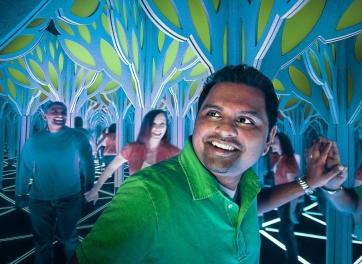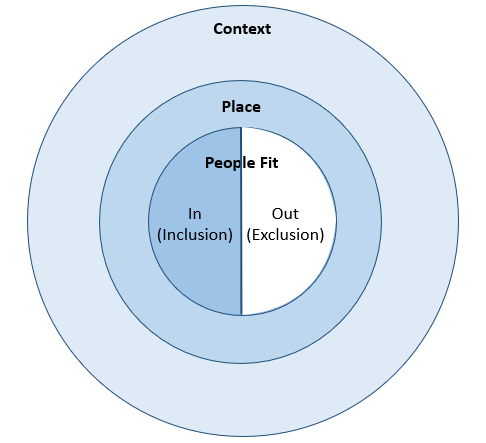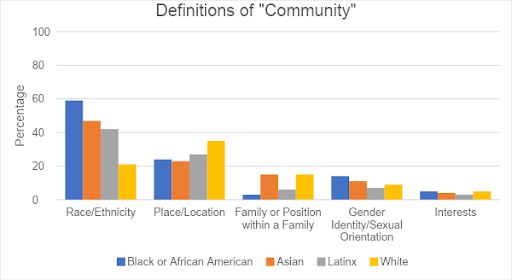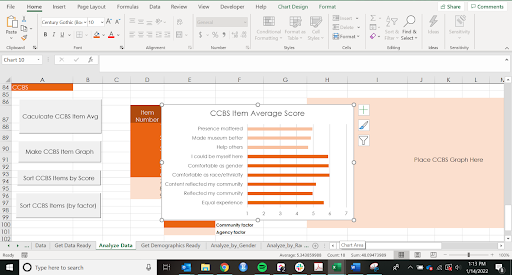A Survey to Measure a Sense of Belonging at Museums and Cultural Centers

Introduction
Although science museums are making efforts to become more inclusive and relevant, they are still not for everyone. Some people would never consider visiting one, even if they pass by it daily (Dawson, 2014). Many factors feed into this feeling (e.g., systemic racism and bias that make science museums irrelevant to many, architecture that belittles nonwhite guests). But they all have at their core the systemic exclusion of people who feel that they are not welcomed and do not belong at museums.
One of the symptoms of social exclusion is a feeling of not belonging to a place or experience. In psychology, a sense of belonging is often considered one of the most fundamental needs to thrive (Maslow placed it after only the physical needs of food and safety). Research on belonging has a strong presence in the fields of education and human development. Still, we could find few empirical studies of belonging in museums and cultural institutions, even though many in the field recognize that it is essential to bring in estranged audiences (Bonnici, 2019; Daenekindt, 2019).
Project Development Process
From the author’s experience studying awe in museums, we recognized the importance of establishing a working definition of belonging. We took two approaches: a literature review and a mini-Delphi project which involves looking for consensus across a wide range of experts. For the literature review, we investigated the psychological frameworks of belonging (of which there were many) and references to belonging in museum literature (of which there were much fewer). We interviewed a wide range of experts, including academic researchers, exhibit developers, guest facilitators, senior leadership in art and science museums, and other museum evaluators and researchers.
Project Implementation Process
The literature review and interviews were used to develop a model of belonging at museums and cultural institutions (Figure 1).

Figure 1. Our model of belonging at museums and cultural institutions.
At the center of the model are people and whether they feel included or excluded in the experience. When talking about belonging, the psychology literature heavily emphasizes welcoming and people fitting in. We felt that exclusion is not simply the opposite, or even a lack of, inclusion but rather its own thing (which may not always be antithetical to belonging). Thus, it needed an explicit place in the model. Next, on-site museum experiences happen within a space, as noted in both the literature and the interviews. Finally, the outer boundary of the model encompasses the context of the visit. This was mostly informed by the interviews, in which the experts described aspects that are unique to museums.
We found some belonging survey instruments that already measure the People Fit and Place aspects of our model. But we did not find any instruments that addressed Context. As a team, we brainstormed a list of questions (items) that may help us measure the unique aspects of a museum visit. We relied heavily on our multiple decades of experience as evaluators and researchers at the Museum of Science and Industry in Chicago. We tested small groups of items by piggybacking them on other surveys at the Museum. We then settled on a group that we pilot-tested together in the summer of 2020. Due to the pandemic, we had to administer the survey online, so it was not an ideal real-world test. Nevertheless, the statistics pointed out some things we needed to work on. We adjusted the survey and then tested it for the first time on the floor of the Museum in the fall of 2020, once we were reopened to the public. Our paper in Curator describes that process and results in detail (and is open-access for all to read).
Project Findings
The goal of this study was to test the survey. We were happy to find that it worked well and avoided many pitfalls of new self-report surveys used in informal science settings, such as being too easy for guests to agree with, or, conversely, using language of belonging that was too esoteric for guests. We also found that the Context aspects of our model could be broken down into two categories: community and personal agency.
Taking a cue from Zacharia and Barton (2004), we recognized that guests would have different definitions of key terms such as "belonging" and "community." So we asked them, "What does the word belonging mean to you?" and "What community were you thinking about when you answered these questions?" We did not find as much variation in the belonging definition as we expected. However, we were struck by the differences in defining community—differences that varied by demographic and cultural background. For example, guests who identified as Black or African American, Asian, or Latinx were twice as likely to think of their community in terms of race/ethnicity than White guests, who tended to think about their location or place of being (Figure 2).

Figure 2. How guests interpreted "community" in their responses.
Insights
We need to conduct follow-up studies (see Next Steps) before we can generalize based on our results. But we were surprised at a few of our findings. First, the reported overall sense of belonging was relatively high. As the journal was reviewing our paper, we collected snapshot data in the summer of 2021, when attendance patterns were returning to normal. We were surprised that belonging scores dropped a small amount. Our theory is that those who visited us during the fall 2020 pandemic surge likely already trusted the Museum and thus reported higher levels of belonging—even though the experience was less than optimal (closed-off exhibits, less interactivity, fewer staff interactions, latent pandemic-related stress, etc.).
Becoming aware of the differences in community definitions has already affected our institution. One staff member said, "I would never have considered that community could mean different things to different people." Now it is an a priori assumption baked into our project planning processes. We often spend a considerable amount of time defining and discussing community at the project-based level.
Next Steps
One of the goals of this project was to create an easy-to-use instrument for the field. This survey is freely available to all. We also wanted to ensure that it was helpful to organizations that do not have research and evaluation teams. Thus, Dr. Lauren Applebaum created a toolkit that includes the survey in Word/PDF formats and an Excel spreadsheet that can be used to analyze the data (Figure 3). The spreadsheet is loaded with macros that will generate graphs and do elementary statistical functions at the click of the button. The toolkit was released in January 2022 and we need additional testers to try it. If you use it, please send us feedback (to studyinfo@msichicago.org) on how we can improve it!

Figure 3. Screenshot from our freely available Excel file to analyze the belonging survey data.
As part of a project funded by the Institute for Museum and Library Services (IMLS), we are planning three follow-up studies in 2022. The first will deploy the survey across ten science and art museums. The second study will perform a cross-cultural validation to see how different cultural groups respond to the survey and what it means to them. The last study will develop a version of the survey that is age-appropriate for pre-teen and adolescent youth.
We are not the only museum-based organization studying belonging. The Science Museum of Minnesota is qualitatively studying belonging, and the Museum of Science, Boston, is exploring feelings of belonging in relation to youth identity and engagement with exhibits. These efforts are all in the early stages, but we are working together to build a community of practice and are open to more discussions and collaborations.
References
Bonnici, S. (2019). Belonging: Co-creating welcoming and equitable museums [Blog post]. https://www.aam-us.org/2019/11/22/belonging-co-creating-welcoming-and-equitable-museums/
Daenekindt, S. (2019). Out of tune. How people understand social exclusion at concerts. Poetics, 74, 101341.
Dawson, E. (2014). “Not designed for us”: How science museums and science centers socially exclude low-income, minority ethnic groups. Science Education 98(6), 981–-1008.
Price, C. A., & Applebaum, L.. (2021) Measuring a Sense of Belonging at Museums and Cultural Centers. Curator: The Museum Journal 65(1) 135-160.
Zacharia, Z., & Barton, A. C. (2004). Urban middle-school students' attitudes toward a defined science. Science Education, 88(2), 197–222.